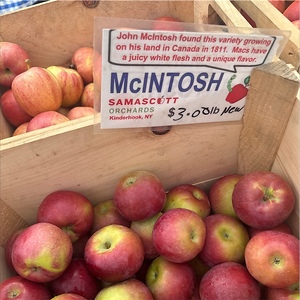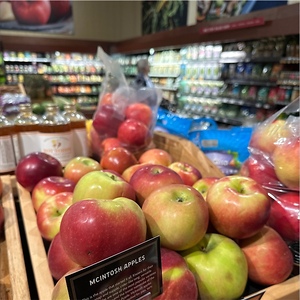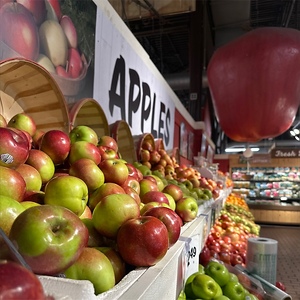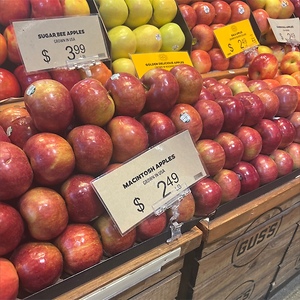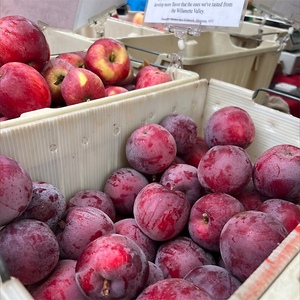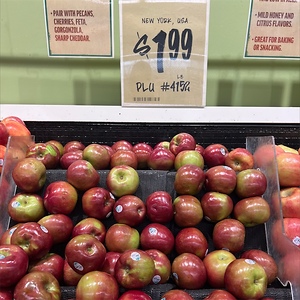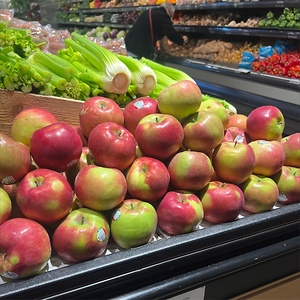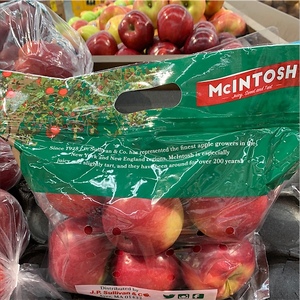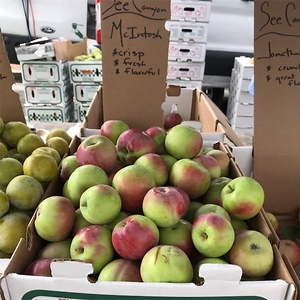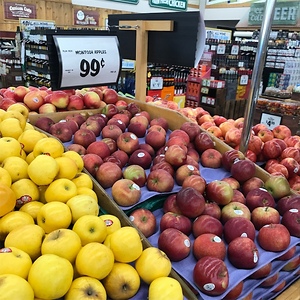

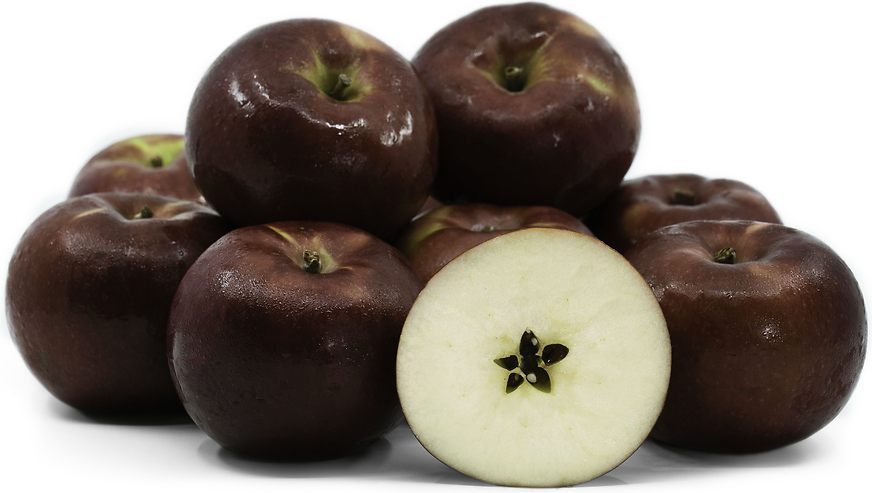
McIntosh Apples
Estimated Inventory, 88 ct : 0
Description/Taste
McIntosh apples are a small to medium-sized varietal, averaging 5 to 7 centimeters in diameter, and have a round to ovate shape, sometimes displaying a slightly lopsided appearance. The apple’s skin is thick and chewy with a yellow-green base coloring, often covered in large patches of muted red blush. The apple’s color will vary, depending on the amount of sunlight exposure mixed with the time of season the fruits are harvested, but the surface also frequently showcases white lenticels and a smooth, matte texture. Underneath the skin, the white to green-tinged flesh is dense, aqueous, and fine-grained with a crisp but soft and tender consistency, encasing a central core filled with brown, oval seeds. The fruit’s delicate nature also causes the surface to be bruised or misshapen if jostled during transportation, so it is best to handle the apples with care. McIntosh apples are aromatic, emitting a honeyed, fruity, and spice-filled fragrance, and the flesh is sweet-tart with an old-fashioned apple cider taste. McIntosh apples harvested earlier in their season will contain high acidity, contributing to a tangier, citrus-like flavor mixed with vinous nuances. If the apples are gathered later in the season, they will sweeten and mellow in taste.
Seasons/Availability
McIntosh apples are available in the fall through early winter.
Current Facts
McIntosh apples, botanically classified as Malus domestica, are a Canadian variety belonging to the Rosaceae family. The heirloom apples were discovered growing as a chance seedling in the early 19th century and were selected for their sweet-tart flavor, crisp and soft flesh, prolific harvests, and cold-weather tolerance. McIntosh apples are also known as McIntosh Red and Mac apples and are an all-purpose variety utilized fresh and cooked in culinary preparations. The apples were once one of the most popular varieties in Canada throughout the 19th century, making up over 40% of the commercial market. McIntosh apples are still a cultivated variety in the modern-day, but growers have decreased production due to the apple’s soft, easily damaged flesh in favor of modern, hardier cultivars.
Nutritional Value
McIntosh apples are a good source of fiber to regulate the digestive tract, vitamin C to strengthen the immune system, and potassium to balance fluid levels within the body. The apples also provide vitamin A to maintain healthy organ functioning, vitamin E to protect the cells against free radical damage, iron to develop the protein hemoglobin to transport oxygen through the bloodstream, and other nutrients including calcium, phosphorus, zinc, copper, boron, and magnesium.
Applications
McIntosh apples are a versatile variety suited for raw or cooked preparations. The apples can be consumed straight, out of hand, appreciated for their sweet and tangy taste, or they can be sliced and displayed on cheese boards, tossed into salads, slaws, and fruit bowls, or layered into sandwiches. McIntosh apples can also be cut and used as a pizza topping, chopped and scattered over breakfast dishes such as oatmeal, or pressed into juices, ciders, and smoothies. In addition to raw dishes, McIntosh apples can be cooked, but it is important to note that their flesh will quickly break down, becoming a soft, sweet, and savory puree. McIntosh apples are often mixed with firmer apple varieties to create pies, tarts, cakes, scones, muffins, bread, and cookies. The apples are also made into applesauce and served with roasted meats, chopped into soups, mixed into stuffing, or simmered into preserves as a sweet treat. McIntosh apples pair well with dense apples such as granny smith, Rome, green dragon, or fuji, maple syrup, caramel, vanilla, nuts including pecans, walnuts, and pine, celery, fruits such as blackberries, cherries, and raspberries, spices like cinnamon, nutmeg, and cloves, and flavorful cheeses such as feta, gorgonzola, and sharp cheddar. It is recommended to store McIntosh apples in the refrigerator as the flesh will develop a mealy texture if left at room temperature. Whole, unwashed McIntosh apples will keep for several weeks when stored in the refrigerator’s crisper drawer. In professional cold storage, the variety will last 3 to 6 months.
Ethnic/Cultural Info
McIntosh apples are famous for lending their name to Apple Inc., one of the most successful technology companies worldwide. Before Apple Inc. became a household name, in 1979, Apple Inc. engineers were designing an inexpensive personal computer to be sold in consumer markets under the code-name ”Annie.” Jef Raskin, a friend of Apple Inc. founder Steve Jobs, joined the secret project and became a lead developer, seeing the project through to completion. Raskin and Jobs agreed that the computer should be named after a distinct apple variety, and Raskin selected McIntosh apples as they represented a unique variety that was loved by a wide demographic. McIntosh apples were also Raskin’s favorite apples at the time. Once the name was decided, the project team realized that there was another company named McIntosh Laboratory, and the laboratory denied Apple Inc.’s request to use the McIntosh name. To avoid infringements and trademark issues, Apple Inc. respelled McIntosh to Macintosh, branding one of the most famous computers in history. In 1986, Apple Inc. later purchased the trademark for their Macintosh name.
Geography/History
McIntosh apples were discovered growing as a chance seedling on a plot of land belonging to John McIntosh in the Dundela hamlet within the Matilda township of Ontario, Canada. McIntosh was clearing sections of his farm in 1811 when he found several apple trees growing naturally. It was unusual for apples to survive in such a cold climate, and while the parentage is unknown, experts believe the seedlings may have developed from discarded European apples. John McIntosh transplanted the seedlings closer to his family home. The apple trees eventually bore fruit, and the sweet-tart, bi-colored apples became a favorite snack of the entire McIntosh family. In the 1820s, the family was selling fruits and seedlings of their new apple variety, but it wasn’t until 1835 that the McIntosh sons discovered that the apples grew true to seed when they were grafted rather than planted with seeds. By 1870, the variety was commercially cultivated in Canada, later being planted in the northeastern United States in the early 1900s. McIntosh apples remained a popular apple variety in North America for many years and were highly favored for their prolific yields, cold-hardy nature, and soft, flavorful flesh. The apples were also decreed Canada’s national apple, imprinting the fruits onto their 1996 Canadian silver dollar. Today McIntosh apples are still prevalent in commercial markets, but their popularity has waned in favor of other, more modern cultivars. The mother McIntosh tree died in 1908, but several commemorative plaques have been placed at the tree’s original location in honor of the variety. McIntosh apples are produced in eastern and central Canada, the northeastern United States, the Pacific Northwest, Eastern Europe, and the Kashmir region of Southeast Asia.
Recipe Ideas
Recipes that include McIntosh Apples. One



